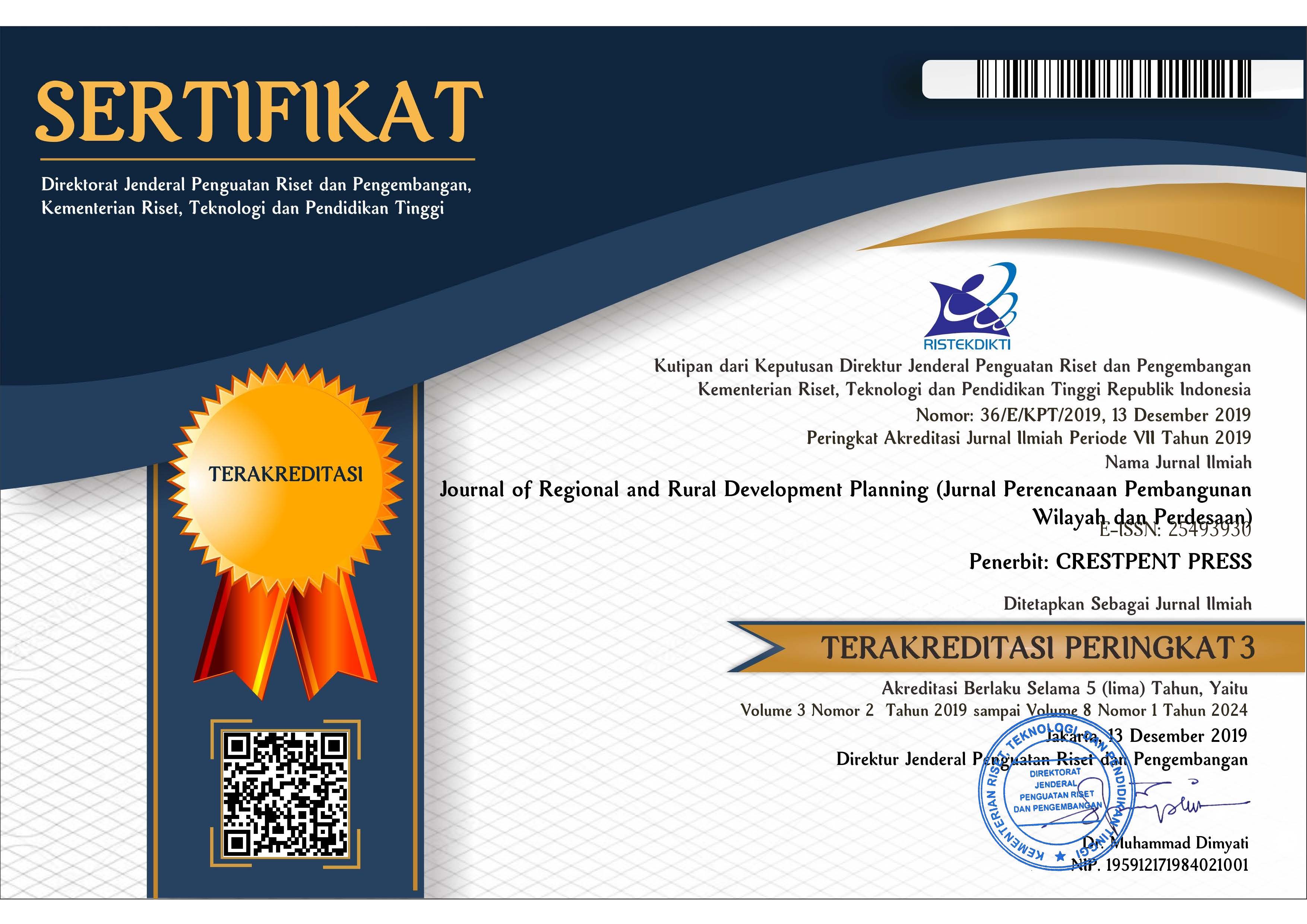Penerapan Geographically Weighted Panel Regression dan Data Envelopment Analysis dalam Pemodelan Kemiskinan di Kalimantan Timur
Abstract
Indonesia currently still needs to focus on achieving sustainable development goals agreed by all countries in the world. Indonesia presently ranks 82nd out of 163 nations in terms of SDG accomplishment, indicating that there is still plenty of potential for improvement. One of the goals that hasn't been accomplished is ‘no poverty’. Regarding the poverty cases, among all province in Indonesia, East Kalimantan is important to be analyzed, because Penajam Paser Utara and Kutai Kartanegara in East Kalimantan are scheduled to become Indonesia's next capital, Nusantara. The goal of this research is to investigate the variables that influence poverty in East Kalimantan and determine the effectiveness of poverty alleviation in the regencies/cities in East Kalimantan. This research used indicator data of poverty from 2019-2021 retrieved from Statistics Indonesia. This research use spatial panel data analysis regression method or Geographically Weighted Panel Regression (GWPR) and Data Envelopment Analysis (DEA). In GWPR model, this research compared adaptive gaussian, adaptive bisquare, adaptive exponential, fixed gaussian, fixed bisquare, and fixed exponential kernel. The findings of this investigation revealed that fixed exponential is the kernel that has lowest AIC and the highest adj-𝑅2. The variables that determine poverty of regencies/cities in East Kalimantan are expenditure per capita, life expectancy, and number of village with higher education facilities. Furthermore, according to DEA, only three cities were effective in addressing poverty: Mahakam Ulu, Paser, and Penajam Paser Utara.
References
Andhyka, R., Handayani, H.R., Woyanti, N. (2018). Analisis pengaruh PDRB, Tingkat pengangguran, dan IPM terhadap kemiskinan di Provinsi Jawa Tengah. Media Ekonomi dan Manajemen, 33 (2): 113-123.
Arief A. (2022). Warga Miskin di IKN Bertambah, Naik Dibanding 2020, Data BPS Ada 12.130 Orang. Kaltimpost, Kaltim. [diakses pada 2023 Mei 4]. https://kaltimpost.jawapos.com/kaltim/18/06/2022/warga-miskin-di-ikn-bertambah-naik-dibanding-2020-data-bps-ada-12130-orang.
Badan Perencana Pembangunan Daerah Kalimantan Timur. (2022). Analisis Ketimpangan Wilayah Tahun 2021KalimantanKalimantan Timur.
Badan Pusat Statistik Kalimantan Timur. (2022). Provinsi Kalimantan Timur Dalam Angka 2022. Badan Pusat Statistik Kalimantan Timur.
Badan Pusat Statistik Kalimantan Timur. (2023). Statistik Pengeluaran Provinsi Kalimantan Timur. Badan Pusat Statistik Provinsi Kalimantan Timur.
Bank Dunia. (2022). East Asia and The Pacific Economic Update October 2022: Reforms for Recovery. World Bank.
Banker, R.D., Cooper, W.W., Seiford, L., M., & Zhu, J. (2011). Returns to Scale in DEA. International Series in Operations Research & Management Science, 164:41-70.
Bastian, A. & Bakhtiar, N.P.A. (2018). Rancang bangun aplikasi sistem pendukung Keputusan penentuan Masyarakat miskin menurut kriteria Kemensos. 9th Industrial Research Workshop and National Seminar, 280-287.
Bruna, F., & Yu, D. (2013). Geographically Weighted Panel Regression. XI Congreso Galego de Estatica e Investigacion de Operations. A Coruna.
Cahyono, R. (2016). Analisis faktor-faktor yang mempengaruhi ketimpangan distribusi pendapatan dan kemiskinan di Kalimantan Timur. Thesis. Universitas Negeri Makassar.
Cai, R., Yu, D., & Oppenheimer, M. (2014). Estimating the Spatial Varying Responses of Corn Yields to Weather Variations using Geographically Weigted Panel Regression. Journal of Agricultural and Resource Economics, 230-252.
Fotheringham, A. S., Brundson, C., Charlton, M. E. (2002). Geographically Weighted Regression: The Analysis of Spatially Varying Relationships. Willey.
Gönner, C., Cahyat, A., Haug, M., & Limberg, G. (2007). Menuju Kesejahteraan: Pemantauan Kemiskinan di Kutai Barat, Indonesia. Bogor: Center for International Forestry Research (CIFOR).
Harianja, Y. (2019). Tingkat kemiskinan di pulau Papua tahun 2011-2017. Thesis. Institut Pertanian Bogor.
Hasanah, R., Syaparuddin, & Rosmeli. (2021). Pengaruh angka harapan hidup, rata-rata lama sekolah dan pengeluaran per kapita terhadap tingkat kemiskinan pada Kabupaten /Kota di Provinsi Jambi. e-Jurnal Perspektif Ekonomi dan Pembangunan Daerah, 10 (3), 223-232.
Hidayah, S. N. (2019). Efisiensi pemerintah dalam mengurangi tingkat kemiskinan tahun 2016-2017. Thesis. Universitas Islam Negeri Syarif Hidayatullah.
Niu, D., Ji, Z., Li, W., Zhen, H. (2022). How to improve the efficiency of global energy interconnection capital allocation? Analysis from the perspective of spatial heterogeneity and driving factors. Journal of Cleaner Production, 330.
Peraturan Bupati Penajam Paser Utara Nomor 25 Tahun 2021. 2021.
Peraturan Presiden Nomor 96 tahun 2015 tentang Perubahan Atas Peraturan Presiden Nomor 15 Tahun 2010 mengenai Percepatan Penanggulangan Kemiskinan. 2015.
Sachs, J.D., Kroll, C., Lafortune, G., Fuller, G., & Woelm, F. (2021). Sustainable Development Report 2021. Cambridge.
Sari, J.N.I., & Nuraini, I. (2020). Analisis faktor yang mempengaruhi tingkat kemiskinan provinsi di pulau jawa. Jurnal Ilmu Ekonomi, 4 (2), 309-323.
Subhi, K.T., & Budiasih. (2019). Kajian produktivitas industri kreatif besar sedang subsektor kuliner tahun 2015. Seminar Nasional Official Statistics. Jakarta.
Yu, D. (2010). Exploring spatiotemporally varying regressed relationships : the geographically weighted panel regression analysis. The International Archives of the Photogrammety, Remote Sensing and Spatial Information Sciences, 134-139.
Copyright (c) 2024 Journal of Regional and Rural Development Planning (Jurnal Perencanaan Pembangunan Wilayah dan Perdesaan)

This work is licensed under a Creative Commons Attribution-ShareAlike 4.0 International License.




.png)














